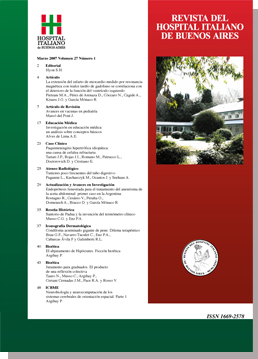La extensión del infarto de miocardio medido por resonancia magnética con realce tardío de gadolinio se correlaciona con el deterioro de la función del ventrículo izquierdo
Main Article Content
Abstract
Cardiac magnetic resonance (CMR) has high special resolution and can accurately measure the myocardial infarction size using late gadolinium enhancement techniques. The identification of areas with myocardial infarction is important to measure no viable myocardium and analyse myocardial viability. The aim of this study was to assess if the extension of myocardial infarction by CMR was associated with the degree of left ventricular dysfunction in patient with history of prior myocardial infarction. In 13 patients the size of myocardial infarction was assessed by determining the degree of infarct transmurality using a left ventricle 17 segment model. The mean ejection fraction was 35 ± 12%. The mean size of the myocardial infarction was 34 ± 15% of the total myocardial mass. The extension of myocardial infarction was correlated with the left ventricle ejection fraction (-0.77, p= 0.013). In conclusion, we identified an inverse correlation between size of myocardial infarction and left ventricle systolic function. CMR may be a useful technique to assess myocardial viability and predict left ventricle dysfunction after myocardial infarction
Downloads
Article Details
Section

This work is licensed under a Creative Commons Attribution-NonCommercial-ShareAlike 4.0 International License.

